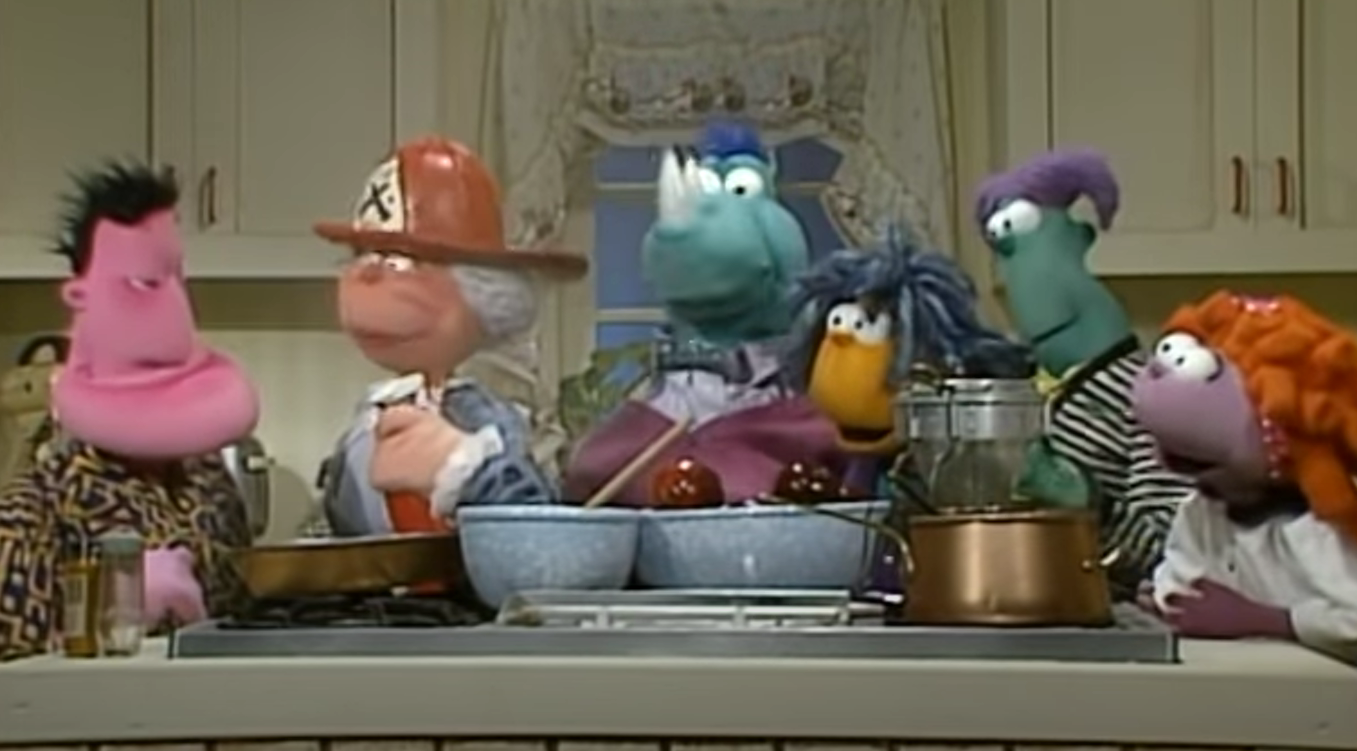I don’t remember how we got on this topic, but on the first night of Hanukkah, I found myself explaining to my non-Jewish wife a TV show I’d watched back in Hebrew day school. Except it wasn’t really a TV show. Or a movie. It was more like a direct-to-VHS educational special—a poor boy’s Sesame Street with none of the charm and the subtlety of a brick.
Nonetheless, I decided, for some dumb reason, to watch, with my two-year-old son, Chanuka at Bubbe’s, a 42-minute independent puppeteer project that has survived on YouTube, thanks to a woman named JoAnn Schneider-Farris, who inexplicably uploaded it 11 years ago. (Comments turned off, thank you very much.)
The backstory of the special has gained some attention since then, because the puppets were designed by David Silverman, who soon went on to be an early animator of The Simpsons—and the look of some characters foreshadowed his later work. (A second Bubbe’s episode was produced about Passover.)
Let me preface the rest of this rant by explaining that I did not want to watch Chanuka at Bubbe’s. I just wanted to watch some Hanukkah content with my toddler while he was sick. Search “Hanukkah” on Netflix, and its algorithm will suggest Jewish foreign films, My Unorthodox Life and a whole bunch of Christmas movies. (The superior Hanukkah episode of the Rugrats animated series from 1996 has also turned up on YouTube and other streaming services—along with a five-minute version.)
Put yourself in my position. Married to a fantastic woman who happens to love Christmas. The kid will grow up watching Christmas classics—enough of which are actually quite good. But when it comes to kids’ Hanukkah programming, how can I compete? Am I supposed to screen every half-assed YouTube cartoon to find something that, just maybe, wasn’t created in a week by underpaid Korean animators?
There just isn’t much out there. I am craving a decent Hanukkah special. But here we are. I can’t think of one. So be it. I’ll fall back into my childhood trauma.
I’ll watch Bubbe’s-goddamn-Boarding House.
The story takes place in the titular boarding house, packed with puppet animals who spend all day seemingly doing little else beyond learning about Jewish holidays. The heart of the home is Bubbe herself, gray hair coiffed in several buns atop her head, pearls dangling from her neck, always patient with everyone around her, including the seemingly stoned delivery boy at the top of the program who asks Bubbe what a dreidel is.
I was surprised, rewatching it, that I remembered absolutely nothing of this show except the theme song, to which I distinctly recall singing along with my friends, as elementary school students, changing the words to “Bubbe’s Boring House”.
Two decades later, the parody version holds up. There are no jokes in Bubbe’s house. There are antics, I guess—like Anton, the stubborn chef in a knock-off Keith Haring shirt with an enormous chin who insists on making tomato latkes that everyone finds disgusting—but at no point does anyone offer a punchline. (Anton later croons an aggressively karaoke-sounding number that includes lyrics such as, “Do it my way/ on every highway”, even though they’re not driving and this line makes no sense—is this comedy?)
This is clearly not a program written by writers, but rather by average Jews who wanted to create a piece of educational content for young Jewish kids. And in that light, I’m glad somebody at least tried to fill the gap that I, as a 33-year-old father, have noticed and bemoaned. Jews are in desperate need of non-shitty holiday content. Our movies, TV episodes and songs often come off painfully educational and woefully lame.
But despite its efforts, Chanuka at Bubbe’s fails in one fundamental way. There is a clear disconnect between what the writers want to communicate, the themes and stories they’re trying to tell, and what kids actually care about. The very concept of creating a kids’ program that takes place in a boarding house is more than a little absurd. It might’ve made sense to a certain generation—waves of Jewish immigrants, for lack of family and language skills, created communities in these homes. Historians estimate that, in the 19th century, as many as 50 percent of Americans either lived in boarding houses or took in boarders at some point.
But the boarding house, infamously crammed and dirty, fell into decline by the mid-20th century, all but disappearing by 1989, when Chanuka at Bubbe’s was released. I genuinely don’t know if, as grade schoolers, my friends and I knew what a boarding house even was. Thinking back, it’s possible we weren’t singing a parody version of the theme song at all—we might have really thought it was called Bubbe’s Boring House.
That stringent focus on history and education, rooted in the program’s very name and setting, seems so profoundly off-base for kids’ programming—so unimaginative and dull—that it’s no wonder I have such dreary memories of it. Great stories require nuance and creativity, clever language and innovative characters. They should spark kids’ natural curiosity and excitement—not lecture them about historical trivia. This was a program made about a bubbe, by a bubbe. But not for kids.
I can’t tell whether my own son actually enjoyed it. Obviously he’s too young for it. But he sat through it. He seemed to appreciate the songs, the puppets, the animals. It’s not like there are any jokes for him to not get. So, despite my better judgment, maybe this won’t be the last time we watch Bubbe’s Boarding House. Maybe one day, years from now, I’ll teach him the parody version of the theme song that I grew up with, and we can sing along together, making our own holiday content—to fill the void that stands before us.
